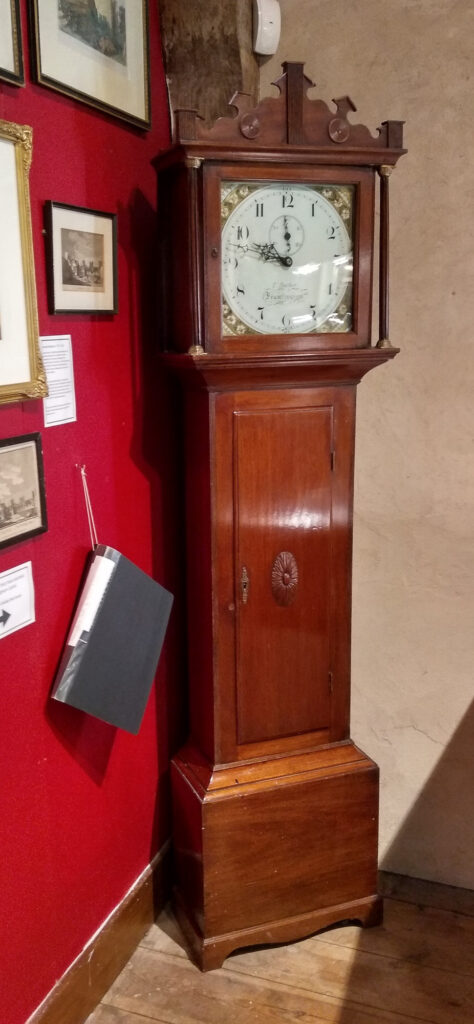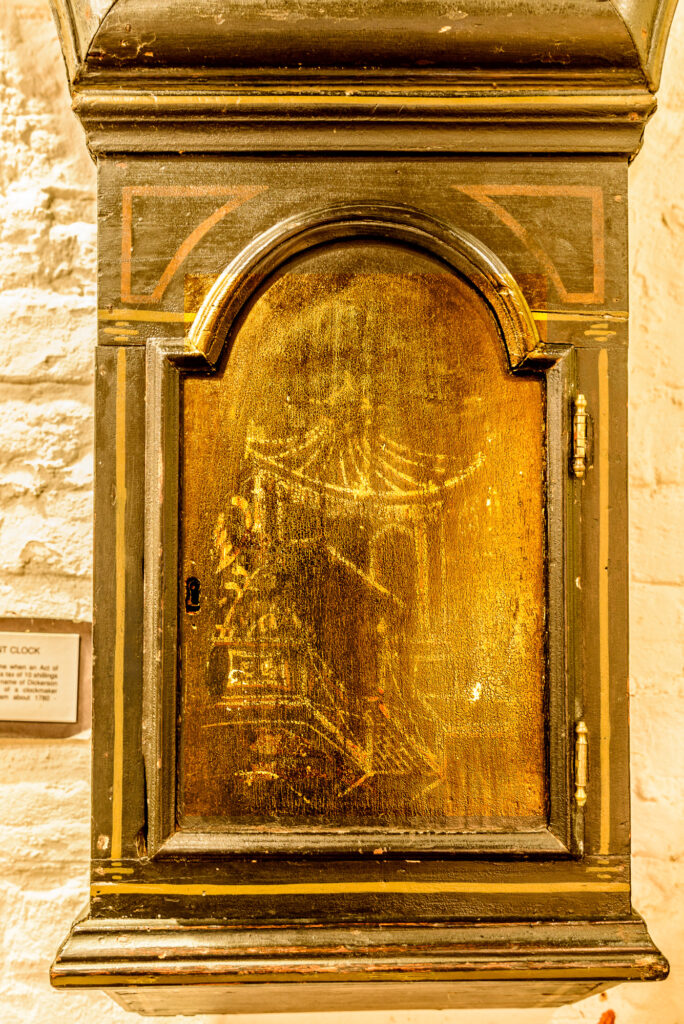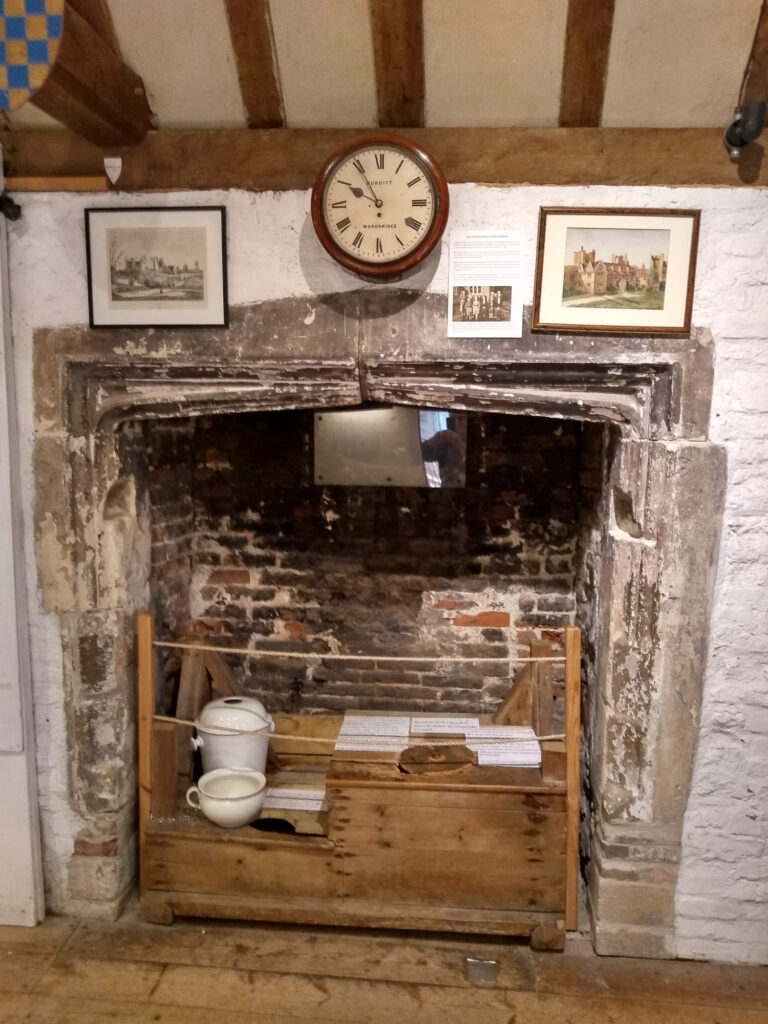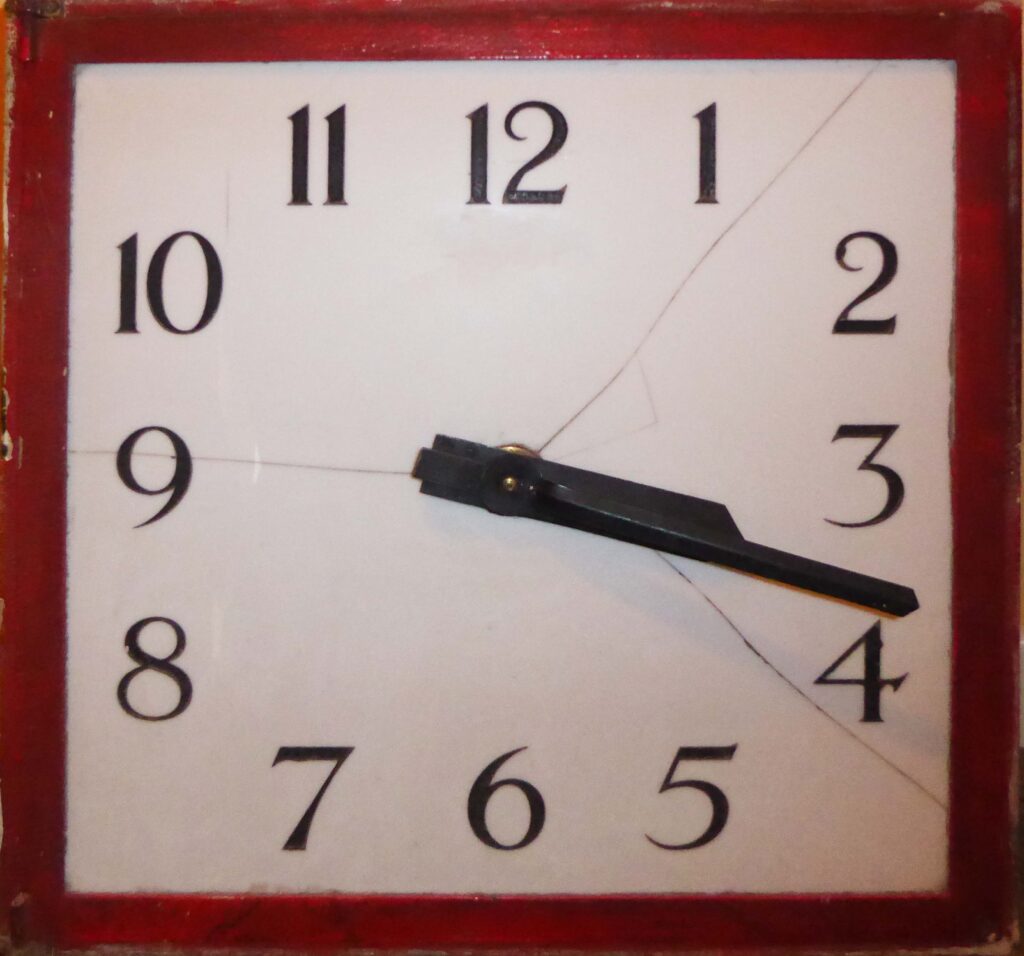By Jerry Hill
Click the images for a close-up of the face. Use the browser “back” function to return here.
On arrival at Framlingham Castle, we work our way up the stairs from the Great Hall, there before us at the summit is a door leading into the Lanman Museum. As we enter, we turn to the right and see a blood red wall from which is hung a significant collection of paintings of the Castle and at either end of that wall are a couple of longcase clocks (grandfather clocks to some).
The nearest to us has the name T. Barker emblazoned on its dial. The clock is small in stature, with painted dial and a perfect size for a low-ceilinged cottage or farm house. The oak case is modest in style and cost. I believed for some years that the good Mr Barker had made a good many clocks in Framlingham, but when I opened the door to the clock there is a label damming in my opinion! The typed label claims the clock came from Birmingham or a Chas. Hawkes of Wickham Market who signed the mechanism within and serviced the clock from time to time. He was born in 1810 and worked until 1860. The label goes on to claim that the case is a replacement. Mr Barker was said to be a repairer and retailer based in Fram.
Now this worries me as I own a Barker longcase clock which spent many years telling people the time at the Crown Hotel in the centre of Fram, before I acquired it. I wonder who made my clock! But let’s return to the mystery of the maker in a moment. The clock is of 30-hour duration meaning you wound it up every evening before bedtime. Now we must remember when these clocks were in their prime, they had to be accurate as there were no ‘phones, radios, computers or TVs to check the time by, so if your clock stopped you were in trouble!

Returning to Mr Barker, he is not listed in any of the clockmaker bibles as a maker although one of his sons Samuel Keer Barker, who continued with his father’s business, is listed as working in Fram between 1823-65 born of Thomas Barker, which is promising! Several local records also confirm that Thomas Barker was making clocks, so my money is on Thomas Barker as the maker, as there are several other clocks attributed to him close to Fram. He made clocks between the 1780’s-1822 when he died.
With that little mystery behind us we move opposite to the next clock, a more up market affair altogether, with silvered dial & highly polished elm (I think) case. Made by Daniel Dickerson who made the 30-hour clock mechanism. He moved to Fram from 1767 – 90, we’ll learn more about him later. He was said to be a maker of good quality clocks, this is also a 30-hour duration needing winding daily. I wonder if the case and dial are original as they look younger to me, but are both of good quality.

Now we walk to our left. Near the fireplace is a massive matt black timepiece (clocks ring out the hours, timepieces don’t, they just tick), the dial is shield shaped hence the name Shield Tavern clock. Early Tavern clocks with shield dials date from around 1755. They endured a tough life mounted in public locations normally hotels or Taverns. Their purpose was to provide the most accurate time in town. How? Firstly, by utilising a top-quality accurate mechanism running for a week or more before needing rewinding & secondly by being adjusted/corrected every time a stage coach arrived from London. The stage coach carried an accurate clock set to London (Greenwich) meantime to enable the Tavern clock’s time to be corrected if necessary. The Tavern clock would be mounted in a high prominent location to be easy to read and out of harm’s way or tampering.


The clock is attributed to Dan Dickerson, who lived an eventful life as described in the notes beside the clock. Born in 1720, apprenticed in Norwich, then when living in Diss 1755 he was declared bankrupt. He clearly made good because by 1767 – 90 he was trading in Framlingham. He moved onto Harleston from 1791. His clocks are noted as being of good quality.
The Lanman Historian, has researched the clocks travels over the years. It seems it was initially hung in a cupola building which used to stand opposite Barclays Bank on Market Hill called the Market Cross. After demolition of the Cupola, the clock went into the new Sir Robert Hitcham school in New Road until 1879. At some point SK Barker acquired the clock. It was then in the Corn Hall/Crown Hotel, when George Cooper purchased it in 1952 and later gifted it to the Lanman Museum.
It’s well worth looking at the very faded painting on the door of the clock depicting (we think) a painting of a cupola type building, which is probably the Market Cross, where it hung, on the Market Hill. The building was demolished in 1788 or thereabouts. It was recorded as an open building, with small shops in the outer circle with the Free Schoolroom in the chamber of the Cross. The painting on the clock case is exactly in line with the above description.
Next, above the fireplace is a typical dial clock (sorry timepiece), not of Fram origin, made by a Mr J. Burditt of Woodbridge, who is recorded as trading in Woodbridge in 1858. Many thousands of dial clocks provided reliable time in offices, schools, railways, hospitals etc. They are sturdy simple honest to God clocks, I love their elegance, simplicity, dependability & robust construction. They were still being made in quantity and quality into the late 1950-60’s. This example was probably made in the 1860-70’s, recently overhauled, its interior is marked with many service/repair dates. The more recent are signed by the A.E. King and later his son Graham, the last clock maker/repairer in Fram.

We have no history of the clock prior to being donated to the Mills Grammar School for girls off Fore Street in 1902. The clock was hung in the Headmistress office adjacent to the two classrooms. The school and its clock continued in service until 1979 when the school was closed, to be replaced by the current Thomas Mills High School. At the time of closure, the clock was donated to the Lanman Museum.
Now we move further along to the left, by the Stewards desk there stands a seven-day longcase clock by C. Percy. He is recorded as born in Mendlesham in 1832, where he started work before moving to trade in Stradbrook from 1855 before moving to Fram where he established his business from 1864-85.
Our clock case is of early Victorian design, later Victorian clock cases got rather broad in the beam & rather ungainly to my eyes. The mechanism is typical of the period and the painted Wilson dial is from Birmingham. The clock sports the most massive weights, I always greatly respect them whilst winding them skywards on their flimsy gut wires.

That almost completes our Lanman clock tour, but I have omitted two clocks on display on the far wall. They have the name Barker and Framlingham adorned on them but they hail from Connecticut USA & were mass produced one by Seth Thomas and the other by Ansonia. Their only connection with Fram is they were retailed by Mr Barker. Such clocks were a nail in the coffin of most provincial clock makers as they could not make clocks as cheaply as these inferior instruments.
Well, that concludes our little tour, come and have a look at our clocks in the flesh along with many other Fram treasures.

As a recent PS – the Museum also displays the clock from the former Regal Cinema in New Road. Not quite so grand as the others!
